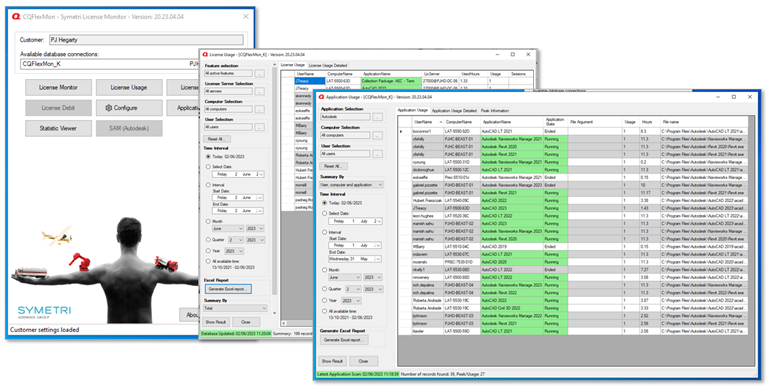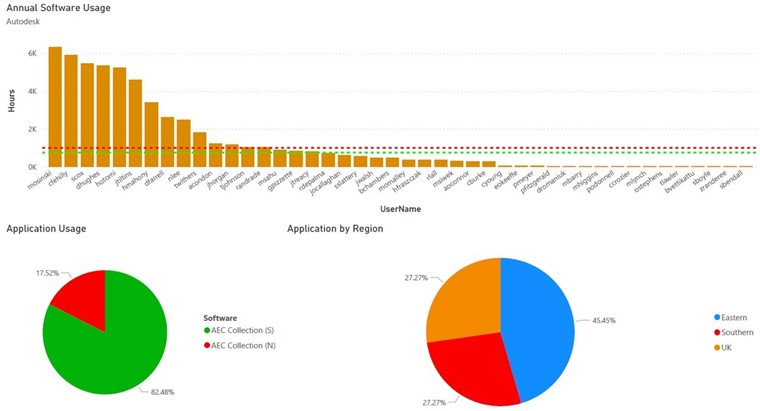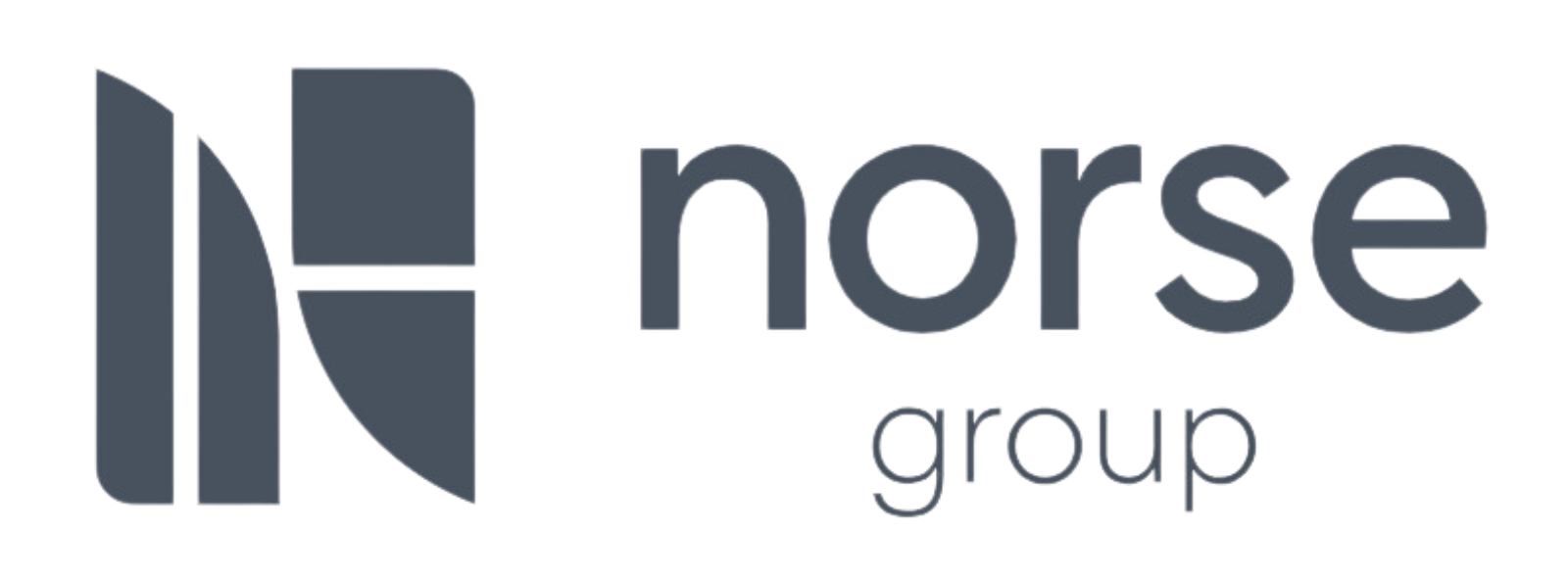
CQFLEXMON ENABLES IRELAND’S MOST PROGRESSIVE BUILDING COMPANY TO CONTROL ITS SOFTWARE LICENCES AND CONTINUOUSLY IMPROVE PEOPLE’S SKILLS

MEET PJ HEGARTY & SONS
Established in 1925, PJ Hegarty & Sons (PJ Hegarty) has emerged as one of Ireland's most progressive building and civil engineering companies. The Company executes projects throughout Ireland and the UK from their Dublin, Cork, Limerick and London offices.
PJ Hegarty has an annual turnover of over €450 million, directly employing more than 450 people, and specialises in large, complex projects in commercial, retail, tourism, pharmaceutical, high-tech and institutional buildings, as well as refurbishment and civil engineering works. Maintaining a safe working environment for all its employees is paramount to the Company, and significant resources are deployed to ensure best practices in the areas of Health and Safety.
PJ Hegarty is dedicated to a sustainable future, reducing its carbon footprint and adopting practices with minimal environmental impact. Leading innovation through technology adoption lies at the core of its strategy to reduce its carbon footprint. By adopting cutting-edge technical solutions and sustainable practices, the Company has committed itself to delivering high-quality construction projects that contribute to a sustainable built environment for future generations.
At PJ Hegarty, its people are the core of its business. The Company takes great pride in fostering a workplace that cares about and values its people. They are committed to being a safe, diverse, and inclusive employer. They understand that embracing and celebrating diversity creates an environment where everyone can be authentic and contribute their unique perspectives, leading to greater innovation, collaboration, and employee satisfaction. This is evidenced by their exceptional staff retention rate across Ireland and UK operations. The Company firmly believes that for its employees to be content and engaged, their professional and personal growth must be nurtured. That is why they go above and beyond to provide development opportunities to create a supportive and enjoyable environment for their people.
THE CHALLENGE: HOW TO GAIN A TOTAL VIEW OF SOFTWARE USAGE?
LICENSED TO INNOVATE
Elements of a perfect storm scenario are whirling round the construction sector, and AEC in general. They are creating fundamental changes and imposing on companies the need to evolve and adapt, to secure their ability to thrive and grow.
The main driver of change is digital transformation. The sector is becoming increasingly paperless, BIM adoption is growing, Digital Twins becoming more widespread, automation accelerating workflows, and collaboration getting far easier between offices and sites, across the supply chain, and between construction companies and their customers.
Accompanying these monumental shifts is the gradually increasing cost of software usage (annual 5% increase in some cases) and the move some vendors are making to the Software as a Service (SaaS) model.
For these reasons, construction software and related technology solutions make up a massively growing market. Companies like PJ Hegarty deploy more software, for more purposes, more of the time.
CHANGES IN THE LICENSING MODEL
“At PJ Hegarty, we have a firm focus on becoming the market leader in digital construction, exploring and embracing technologies, not least those that pertain to Building Information Modelling”, says Anthony Condon, PJ Hegarty’s BIM and Digital Construction Manager.
“We have a large team of engineers and land surveyors for whom the regular use of software is core to how they work. Historically, that has meant that we had an extensive portfolio of software licences current at any moment in time.
With the announcement from numerous vendors of network licences disappearing as an option, we became aware that the cost-hit of moving to named user licences was likely to be somewhat on the high side — the unacceptably high side — but figured that while this may have been an inevitable scenario, there could be ways of minimising its impact.
I asked Symetri what we could do. The change in licensing was an event that Symetri had long anticipated. They delivered that classic strategic re-focus of turning a problem into an opportunity. They introduced us to CQFlexMon”.
THE SOLUTION: CQFLEXMON — TAKING CONTROL OF THE LICENCE PORTFOLIO
ONE SOLUTION BINDS THEM ALL
“Construction is trust-friendly”, says Anthony, “And Symetri has always had our back, such that the trust between our two teams is deep. They’re knowledgeable, customer-focused, and seemed to have the answer to any software issue or need we’ve ever thrown at them. The licensing problem was no different”.

Symetri suggested that the first thing Anthony needed to do was relieve the pressure of making immediate and potentially very costly licence decisions. Far from rationalising PJ Hegarty’s licenses as a first step, Symetri recommended that more were purchased under the old network licence regime, allowing the company a three-year window before making the final move to named-user licences.
Then the Symetri team showed Anthony what CQFlexMon could do to enable PJ Hegarty to take control of its licence portfolio, which, as Anthony said, was ‘very wide’. “It was great to see that CQFlexMon wasn’t uniquely aligned to Autodesk licensing”, says Anthony. “It could be used on licenses for Microsoft, Adobe, Bluebeam and others”.
KNOW YOUR USAGE PATTERNS – KNOW YOUR LICENCE NEEDS
When PJ Hegarty adopted CQFlexMon, Symetri undertook a process of discovery. Against an assumption that many of Symetri’s customers make — that there may be a requirement for tweaks in licensing arrangements — comes a realisation that software usage by person does not always align with the software investment.
“In the normal run of business, issues to do with licences do not rise to the surface”, says Anthony, “given that they have no discernible impact on project outcomes”. It becomes a case of no ‘squeaky wheel’ to oil.
PJ Hegarty started using CQFlexMon in mid-2021. By mid-2023, it had two years of data to use as a reliable guide to the company’s software licensing requirements; a financial rationale supported by firm proof of need.
By getting to grips with PJ Hegarty’s software usage data — historical through to up-to-date — the true picture emerged:
- Data analysis
To prove the efficacy of CQFlexMon, the Symetri team initially gathered six months of PJ Hegarty usage data and analysed it to identify usership by high users and less frequent users (‘fits and bursts’; peaks and troughs/reviews and approvals). - Data insights
The data gathering phase brought an immediate CQFlexMon benefit even though this was just effectively a ‘proof of concept’ stage. PJ Hegarty had over 100+ licences for Autodesk AutoCAD LT, which had been assumed to be the ongoing requirement for the company’s engineers and surveyors. This number had been sufficient for the team’s needs, caused no concern, and was accommodated within the overall budgeting process. CQFlexMon usage analysis highlighted the vagaries in usage, enabling the company to cut 20% of all its licences by aligning proven use to licence requirements. - Triggers to action
“Having reams of data is only valuable if you can make sense of it”, says Anthony. “Symetri solved this issue by creating Power BI dashboards for us, so that data is visualised and can be easily and quickly understood and acted on. They created an invaluable data visualisation tool in the form of Flex Alarm — you see exactly what’s happening all the time”.
Flex Alarm indicates a threshold usage level at which usage patterns would need to be explored. It shows the level at which 75% of that usage has been hit in practice, triggering the likely need for intervention.
“Some heavy users are meant to be precisely that, because it’s in the nature of their role and their workflows. When the individual doesn’t match that profile, action needs to be taken. CQFlexMon tells me when to be concerned, and I don’t have to check unless the alarm suggests I should”.

THE OUTCOME: OPTIMISED SOFTWARE USAGE COMBINED WITH BETTER SKILLS INSIGHTS
PJ Hegarty believes that people are its greatest asset. It encourages and supports all staff in their training. “We care about our people”, says Anthony, and that’s a commitment that comes to life in how we work with our staff to help them keep abreast of the relevant skills they have.
Know your users – know your support priorities
HEAVY | LIGHT | INFREQUENT: ALL USES ADDRESSED
“Once a month, we look closely at what licenses have been used, for what purpose in a project and by whom. We also have data on the number of hours the software was used. Everything is clarified and verified by data.
While this enables us to allocate licences based on identified work patterns more precisely, there remained the issue of infrequent users — having usage that doesn’t justify a full licence; the reviewers, management taking a look, approvals; that sort of thing”, says Anthony. “CQFlexMon addresses this issue with Flex tokens. Now we pre-pay for batches of Flex tokens that can be used as and when ad hoc tasks arise. It’s a ‘consume as you go’ model that really does provide flexibility and takes the complication out of the infrequent user situation”.
PJ Hegarty has gained control over its licences with CQFlexMon, across almost the entirety of its software portfolio. But it’s far more than just a financial benefit. By having detailed insight into work patterns, Anthony turns to the solution to aid continuous learning.
With the construction sector becoming increasingly digital and subject to ongoing disruption due to the rapid pace at which technology is developing, some individuals’ skills can require regular revisiting and re-calibrating. Other individuals are digital natives, with skills that can be best used only once they are fully understood.
KEEPING EVERYONE UP TO SPEED AND HAPPY
“When we spot a user clocking up high hours where they wouldn’t generally be expected, we can have a chat and ask how we can help. For example, if someone spots a file problem, cleans the file, and removes the problem, this would be regarded as a quick fix. If the hours exceed expectations, we look at it further.
We have this visibility across all our offices and all our users. Where an individual needs help, we can offer one-on-one guidance or sort out some training. The opposite is also true — where an individual is so technology-savvy that every job moves swiftly — in less than the expected time a task might take — we can look at whether we’re maximising that individual’s talents. CQFlexMon enables us to keep everyone happy; management, finance, engineers, and surveyors”.
Related Cases


The Cloud Transformation Experience at Norse Consulting
Improving data management and implementing digital workflows—through cloud transformation—are very much key focus areas at Norse Consulting. Daniella Barrow, Senior Director of the organisation, outlines the goals and progress, with observations o... Learn more



